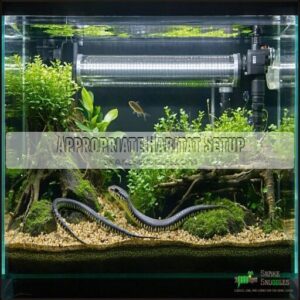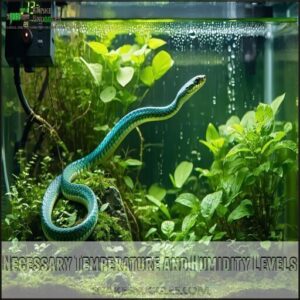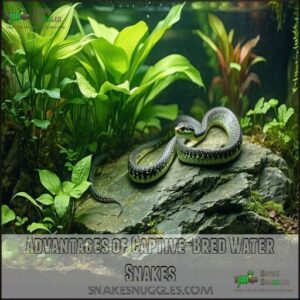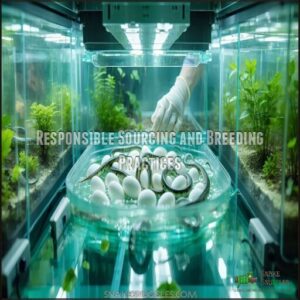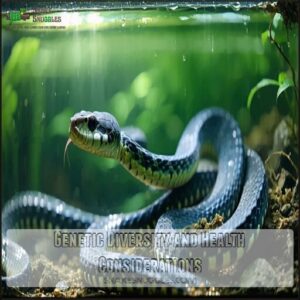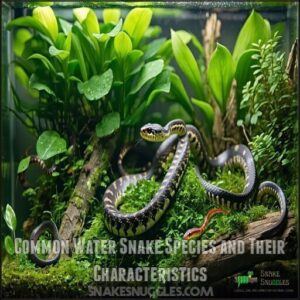This site is supported by our readers. We may earn a commission, at no cost to you, if you purchase through links.
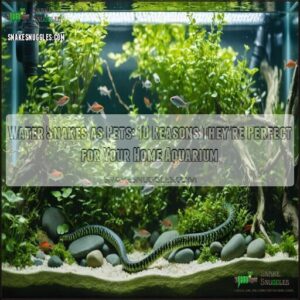
These aquatic reptiles, like Northern water snakes or crayfish snakes, thrive in well-maintained tanks with proper heating, humidity, and enrichment.
They’re not venomous, but they can be a bit shy at first—patience is key when handling them, and their sleek movements and striking patterns make them mesmerizing to watch.
Feeding is straightforward, usually involving fish or amphibians, though some species adjust to frozen-thawed options.
Just be sure to source captive-bred snakes to guarantee ethical practices and better health, and consider making your aquarium a little wilder.
Table Of Contents
- Key Takeaways
- The Allure of Water Snakes as Pets
- Providing a Healthy and Enriching Environment for Water Snakes
- Captive Breeding and Its Benefits
- Handling and Interacting With Water Snakes
- Common Water Snake Species and Their Characteristics
- Frequently Asked Questions (FAQs)
- Can I keep a sea snake as a pet?
- What do pet water snakes eat?
- Can you handle water snakes?
- What is the most pet friendly snake?
- Can I have a water snake as a pet?
- Are water snakes friendly?
- What to feed a water snake?
- What is the average lifespan of a water snake?
- Can water snakes be potty trained?
- How much space do water snakes require?
- Conclusion
Key Takeaways
- You’ll need a spacious tank with both land and water areas, proper temperature control, and enrichment items to keep your water snake healthy and active.
- Feeding is easy—stick to a diet of fish, amphibians, or frozen-thawed rodents, and add occasional calcium supplements for balanced nutrition.
- Regular, gentle handling helps water snakes relax over time, especially with captive-bred ones that are naturally calmer than wild-caught specimens.
- Always source captive-bred snakes to support ethical practices, avoid parasites, and ensure a healthier, easier-to-handle pet.
The Allure of Water Snakes as Pets
You’ll discover that water snakes from the Natricinae family make surprisingly adaptable pets when properly handled and socialized, even for beginners with limited experience.
Water snakes from the Natricinae family offer a unique mix of adaptability, low maintenance, and fascinating behaviors, perfect for beginners and enthusiasts alike.
Their moderate size of 2-4 feet and diurnal nature make them more interactive companions than many other reptiles, offering you a unique opportunity to observe fascinating aquatic behaviors right in your home aquarium, with their ability to be surprisingly adaptable pets and provide a chance to see fascinating aquatic behaviors.
Docile and Easy-to-Handle Nature
Why are water snakes considered among the most docile reptilian pets? With proper socialization, these fascinating creatures adapt remarkably well to human interaction, making them excellent companions for beginners.
- Taming wild snakes requires patience, but captive-bred specimens show natural docility within weeks
- Regular handling frequency (2-3 times weekly) dramatically reduces bite risk factors
- Most Natricinae species rank as top beginner snake species due to their calm demeanor
- Snake socialization starting with brief 5-minute sessions builds trust effectively
- Young water snakes learn to associate humans with safety, not predation
Their defensive behaviors typically fade with consistent, gentle handling. Once acclimated, you’ll find water snakes as pets offer safe handling experiences with minimal stress—just remember to support their bodies properly and avoid sudden movements.
Lower Maintenance Requirements Compared to Other Snakes
Unlike their more demanding reptilian relatives, water snakes truly shine as low-maintenance pets for your home aquarium.
You’ll find their care requirements pleasantly simple compared to other snake species.
A standard 40-gallon breeder tank provides ample space for these clean creatures, who rarely make messes beyond their occasionally smelly, watery feces.
Water snake care revolves around maintaining proper temperatures (70-90°F) and providing weekly enclosure cleaning.
Their feeding frequency is manageable—juveniles eat twice weekly while adults need just one meal per week.
Shedding assistance is minimal, and veterinary costs tend to be lower than for more specialized species.
Their easygoing temperament means less stress during handling, though they may strike if feeling threatened.
With proper pet water snake research, you’ll discover they require far less attention than dogs, cats, or even more specialized snake species.
They are ideal for those looking for simple and clean pets, offering a unique experience with minimal maintenance and care.
Increasing Popularity in The Pet Trade
Why are water snakes swimming into the pet trade spotlight? These fascinating reptiles are gaining traction among enthusiasts seeking alternatives to traditional snake pets.
Their manageable size and interactive behaviors make them increasingly appealing to beginners. Market demand continues to rise, though breeding challenges persist.
While you’ll find growing online communities sharing pet water snake care tips, ethical concerns and conservation impact remain important considerations.
Proper regulation needs attention as more hobbyists discover these aquatic reptiles. Before acquiring one, research beginner snake pet guides to guarantee responsible ownership.
Providing a Healthy and Enriching Environment for Water Snakes
You’ll create a thriving habitat for your water snake by establishing proper temperature gradients (70-85°F with a 90°F basking spot) and including both aquatic and terrestrial areas in a spacious enclosure.
Your slithery companion will stay healthy and display natural behaviors when you provide adequate hiding spots, climbing structures, and a proper diet of fish supplemented with occasional frozen-thawed rodents.
Appropriate Habitat Setup
Creating the perfect water snake habitat requires careful attention to their unique needs.
Your enclosure design should replicate their natural environment with both land and water areas.
Here’s what you’ll need:
- Tank Size: Choose a 40-gallon aquarium minimum for adult water snakes
- Substrate Choice: Use coconut fiber or reptile carpet for the dry portion
- Water Quality: Install a reliable filtration system to maintain cleanliness
- Basking Area: Create an elevated platform with temperatures of 85-90°F
- Hiding Spots: Provide multiple shelters using cork bark, rocks, or commercial hides
Remember, these semi-aquatic reptiles need space to swim and climb while maintaining proper humidity.
These snakes also require the ability to control their buoyancy to thrive.
Necessary Temperature and Humidity Levels
The thermometer doesn’t lie—your water snake’s comfort depends entirely on proper temperature zones and humidity levels.
Establish a temperature gradient with a basking spot at 85°F and cooler areas around 70°F, while maintaining humidity between 30-60%. A reliable temperature reading is essential for water snake health.
| Temperature Zone | Ideal Range | Monitoring Equipment |
|---|---|---|
| Basking Area | 85-90°F | Digital thermometer |
| Cool Side | 70-75°F | Probe thermometer |
| Water | 75-78°F | Submersible gauge |
During shedding periods, increase humidity to 65-70% to help your serpentine friend slip out of its old skin effortlessly. Remember, proper thermoregulation isn’t just comfort—it’s survival for these remarkable reptiles, and maintaining the right humidity levels is crucial for their well-being, especially in creating a suitable temperature gradient and ensuring a reliable temperature reading.
Suitable Food and Feeding Practices
Now that you’ve mastered temperature control, let’s talk about feeding your water snake properly.
Your piscivorous friend will thrive on a balanced diet that includes:
- Frozen-thawed rodents as a nutritional base
- Occasional feeder fish (like comet goldfish) as treats
- Small, appropriately-sized prey matching your snake’s body width
- Calcium supplements dusted on food items
- Fresh, clean water changed daily
Establish a consistent water snake feeding schedule—every other day for juveniles and weekly for adults. Consider ordering frozen rodents to guarantee a steady supply.
Always use feeding tongs to avoid accidental bites. Remember, a healthy snake maintains a sleek, athletic build without appearing overweight. Your slithery companion’s dietary needs aren’t complicated, just consistent!
Importance of Enrichment and Stimulation
While proper feeding sustains your water snake’s health, enrichment activities transform their enclosure into a stimulating environment that supports their natural behaviors and cognitive needs.
Enrichment activities turn your water snake’s habitat into a dynamic space, fostering natural behaviors and keeping them mentally stimulated.
Your snake’s habitat should recreate their wild home, providing environmental complexity that keeps their activity levels high while reducing stress.
- Mix textures and levels in the enclosure: smooth river rocks for basking, cork bark for climbing, and soft substrate areas that satisfy their instinctual needs
- Rotate hiding spots monthly using caves, plants, and hollow logs to maintain environmental stimulation and prevent boredom
Consider establishing a bioactive terrarium system with living plants and beneficial organisms. This setup encourages snake behavior like exploring and hunting. Add water features with varying depths for swimming enrichment, and introduce new scents through safe materials to promote cognitive stimulation. To further enhance their habitat, consider specialized snake products designed for enrichment. Your snake’s enclosure isn’t just housing—it’s their entire world, deserving thoughtful design.
Captive Breeding and Its Benefits
You’ll find that captive-bred water snakes offer significant advantages over wild-caught specimens, including better temperament, reduced parasites, and greater adaptability to domestic environments.
Choosing responsibly bred snakes also supports conservation efforts and provides you with a healthier pet that’s more likely to thrive in your carefully designed aquatic habitat, which is a key factor in their overall well-being and adaptability.
Advantages of Captive-Bred Water Snakes
Several captive-bred water snakes offer remarkable advantages over their wild counterparts. You’ll notice their tamer temperaments and adaptability to handling since they’ve grown accustomed to humans from birth.
These captive-bred specimens typically carry reduced parasites and established feeding patterns, making your pet journey smoother. Beyond health benefits, choosing captive-bred snakes supports conservation impact and addresses ethical considerations in the pet trade—a win-win for both snake health and genetic diversity.
To optimize breeding, it’s important to understand cooling period needs for each species, which can have a significant effect on the breeding process and ultimately the pet trade.
Responsible Sourcing and Breeding Practices
Choosing a water snake through ethical acquisition guarantees both conservation and pet quality.
When searching for your aquatic companion, prioritize reputable breeders who maintain detailed health records and practice responsible breeding techniques.
These professionals comply with legal regulations while supporting genetic diversity in captive populations.
Unlike their wild-caught counterparts, captive-bred water snakes typically offer friendlier temperaments and better adaptation to home aquariums.
You’ll want to verify breeder reputation through transparent documentation—legitimate sources gladly share their breeding methods and snake lineage.
By supporting eco-friendly breeding practices, you’re getting a healthier pet while also reducing conservation impact on wild populations.
It’s a win-win for everyone!
Genetic Diversity and Health Considerations
Genetic diversity flows through your water snake’s veins, ensuring long-term health and vitality.
When selecting captive-bred specimens, consider these essential factors:
- Hybrid vigor naturally strengthens disease resistance, preventing complications from inbreeding depression
- Diverse genetic pools combat genetic bottlenecks, reinforcing your snake’s immune system strength
- Responsible snake breeding genetics reduce hereditary conditions common in closely-related lines
- Conservation genetics principles, when applied to captive breeding, yield healthier pets
You’ll find that snakes from genetically diverse backgrounds adapt better to captivity, resist illness more effectively, and typically live longer lives.
It’s like having insurance for your scaly friend’s future!
Handling and Interacting With Water Snakes
You’ll find that establishing trust with your water snake requires consistent, gentle handling techniques that respect the animal’s natural behaviors and boundaries.
With proper socialization, even wild-caught specimens can become comfortable with your touch, transforming from defensive biters into fascinating companions that will actively explore your hands and arms during interaction sessions, leading to a deeper understanding of their natural behaviors and boundaries.
Acclimating New Pets to Human Interaction
The first 14 days with your water snake are vital for successful socialization.
After your new pet settles in, begin the acclimation process by simply placing your hand in the enclosure, allowing it to recognize your scent.
Reducing stress is your priority—never rush this process.
Gradually progress to gentle touches at mid-body, building trust through consistent, brief interactions.
Many water snake owners find that positive reinforcement works wonders; try offering food with long tongs after successful handling sessions.
This patience prevents bites and develops a calmer snake temperament.
Safe Handling Techniques
After establishing initial trust, mastering safe handling techniques will protect both you and your water snake. Always use a secure grip that supports your snake’s body while minimizing stress.
Follow these snake handling tips for success:
- Place hands every 6-8 inches along the body to prevent dangling (snakes hate feeling unsupported!)
- Move deliberately, never suddenly to avoid triggering defensive strikes
- Watch for tense muscles or rapid tongue flicking that signal discomfort
- Wash hands before and after handling to maintain proper hygiene practices
Read body language carefully—an S-shaped posture often precedes defensive behavior. Remember to prioritize snake hook utilization for maintaining a safe distance. For new specimens, lightweight handling gloves offer protection while avoiding bites.
Developing a Bond With Your Water Snake
After mastering safe techniques, it’s time to build a meaningful relationship with your water snake.
Trust building happens through consistency and patience.
You’ll know you’re making progress when:
- Your snake displays relaxed body language during handling sessions
- Their tongue flicks become curious rather than defensive
- They willingly explore your hands without trying to escape
Start with brief 5-minute interactions and gradually increase handling frequency as your pet grows comfortable.
Watch for subtle cues that signal stress or contentment.
Positive reinforcement through gentle movements and reducing stress in their environment helps water snake socialization immensely.
Remember, some species bond more readily than others, but patience always wins the race.
Common Water Snake Species and Their Characteristics
You’ll find several fascinating water snake species suitable for your home aquarium, including the docile Northern Water Snake, fish-loving Banded Water Snake, and the uniquely colored Red-bellied Water Snake.
Each species has distinct characteristics that influence their care requirements, from the smaller aquatic garter snakes that hunt fish to the larger brown water snakes that need spacious enclosures for climbing and basking.
Nerodia Species (Northern Water Snakes)
Northern Water Snakes (Nerodia sipedon) are the water-world warriors of the reptile kingdom, reaching 61-140cm in length.
Their distinctive dark coloration with square blotches makes them visually striking additions to your home aquarium.
While they’ve earned a reputation for temperament concerns, proper habitat enrichment minimizes defensive behaviors in these non-venomous swimmers.
| Feature | Habitat Needs | Care Level |
|---|---|---|
| Size | 24-42 inches | Moderate |
| Diet | Fish & amphibians | Easy |
| Temperature | 75-85°F | Simple |
| Activity | Diurnal | Manageable |
They are non-venomous swimmers and with proper care, can thrive in a well-maintained aquarium, offering an interesting and visually striking display.
Regina Species (Crayfish Snakes)
Crayfish snake enthusiasts find Regina species to be among the most specialized water dwellers in the aquatic snake world. These small to mid-sized creatures (14-28 inches) display striking brownish to olive coloration with distinctive light striping patterns.
Your Regina species will require thoughtful crayfish snake care with an enclosure that mimics their natural habitat.
A proper Regina enclosure needs include:
- A 30-gallon tank divided between land and water sections
- Multiple submerged hiding spots using rocks and aquatic plants
- A reliable filtration system to handle their primarily crustacean Regina diet
Unlike their sometimes-aggressive cousins, these nocturnal specialists showcase a relatively docile temperament, rarely biting when handled. Their specialized hinged palatine teeth are perfect for their favorite meal—crayfish—making feeding time quite the spectacle in your home aquarium.
Seminatrix Species (Black Swamp Snakes)
Many Black Swamp Snakes (Seminatrix species) captivate hobbyists with their glossy black bodies and striking red-orange bellies. These small, nonvenomous snakes rarely exceed 22 inches, making them perfect for modest aquariums.
For successful Seminatrix habitat setup:
- Maintain heavily vegetated wetland environments with 50-60% humidity and multiple hide spots to reduce stress
- Provide clean, shallow water areas for swimming – they’re highly aquatic by nature
- Offer a varied Black Swamp diet including small fish and earthworms about twice weekly
Unlike their relatives, these aquatic snake species demonstrate remarkably docile temperaments, rarely biting even when handled.
Liodytes Species (Rainbow Snakes)
Looking for a truly spectacular aquatic pet? Rainbow snakes (Liodytes species) offer a dazzling display with their glossy black bodies adorned with three vibrant red stripes running the length of their bodies.
These nonvenomous snakes thrive in a proper Liodytes habitat that mimics their natural wetland environment. Snakes use serpentine movement to navigate these environments with ease.
Your captive Liodytes will appreciate a tank with varied water depths, smooth river rocks, and dense vegetation for hiding. Rainbow snake diet in captivity typically consists of fish alternatives, though wild specimens are known as "eel moccasins" for their preferred prey.
| Feature | Description | Care Needs |
|---|---|---|
| Size | 3-4 feet | 55+ gallon tank |
| Temperament | Docile, rarely bites | Gentle handling |
| Natural Diet | Primarily eels | Fish alternatives |
They’re generally easy to feed compared to some other aquatic snake species. Despite their beauty, consider Liodytes conservation status before purchasing, as responsible reptile pet care always comes first.
Frequently Asked Questions (FAQs)
Can I keep a sea snake as a pet?
You can’t keep a sea snake as a pet.
They’re highly venomous, require specialized care, and thrive in saltwater environments that are nearly impossible to replicate at home.
Stick to freshwater species for safer options.
What do pet water snakes eat?
Feeding a water snake isn’t rocket science, but it takes planning.
They primarily eat fish like goldfish or minnows, occasionally amphibians, and can adapt to frozen-thawed rodents.
Add calcium supplements for balanced nutrition.
Can you handle water snakes?
You can handle water snakes, but do it gently and confidently.
Wild-caught ones might nip defensively, while captive-bred snakes are usually calmer.
Regular, careful handling helps them relax, but always respect their boundaries and temperament.
What is the most pet friendly snake?
Imagine a snake that’s calm, curious, and easy to care for—corn snakes fit the bill perfectly.
They’re non-venomous, manageable in size, and thrive with basic care, making them ideal for beginners and families alike.
Can I have a water snake as a pet?
You can, but water snakes need specific care.
They require a spacious tank with water and land areas, a fish-based diet, and proper temperature control.
Research local laws and species needs before committing.
Are water snakes friendly?
They’re not naturally cuddly, but with patience and proper handling, many water snakes can become calm around humans.
Wild-caught ones might act defensive, but captive-bred snakes are generally easier to socialize and manage.
What to feed a water snake?
Don’t let their diet intimidate you—feed your water snake a mix of fish, like thawed goldfish or minnows, and occasional amphibians.
Add calcium supplements, and always match prey size to the snake’s body width.
What is the average lifespan of a water snake?
The average lifespan of a water snake is over 10 years with proper care.
It depends on factors like diet, habitat quality, and health checks.
Treat them right, and they’ll stick around for years!
Can water snakes be potty trained?
You can’t potty train a water snake, but luckily, they’re predictable.
They often relieve themselves in water.
Providing a designated water area simplifies clean-up and helps keep their habitat fresh and less smelly.
How much space do water snakes require?
A common theory suggests water snakes don’t need much room, but they actually thrive with at least 4 feet of tank length.
Add hiding spots, basking zones, and swimming space to keep them happy.
Conclusion
Owning water snakes as pets isn’t exactly the snake-oil salesman’s pitch—it’s a solid choice for reptile enthusiasts.
These sleek, aquatic companions offer a unique blend of beauty and low-maintenance care, thriving in carefully maintained environments.
With proper tank setups, conscientious feeding, and ethical sourcing of captive-bred snakes, you can create a mesmerizing piece of nature in your home.
As you bond with your snake’s graceful movements, you’ll appreciate how rewarding keeping water snakes can truly be.


